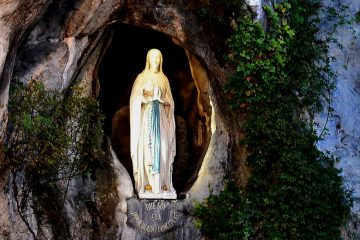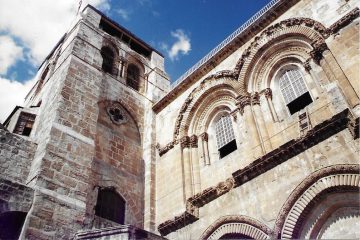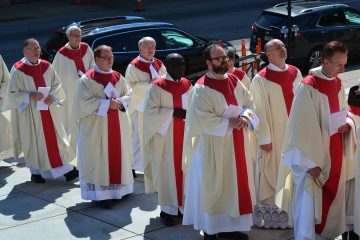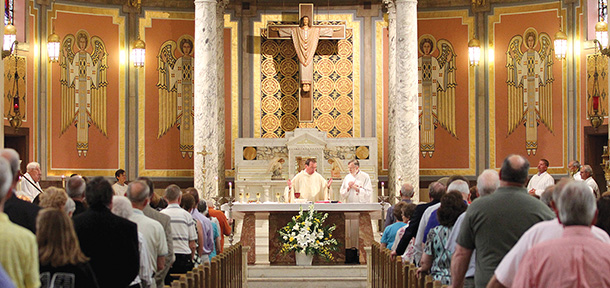Parishes face challenges, rewards as pastoral regions form
Editor’s Note: This is the third and final in a multi-part series on pastoral regions, an ongoing effort to mitigate the decline in the number of available priests for assignments as pastors on the parishes of the Archdiocese of Cincinnati.
By Eileen Connelly, OSU
The Catholic Telegraph
Pastors and members of archdiocesan parishes that are forming or have formed pastoral regions acknowledge there are challenges as they come together. Yet, they say, the rewards outweigh the challenges as they look to the future as unified, vibrant faith communities.
Previous Entries in this series
Pastoral Region story Part 1
Pastoral Region story Part 2
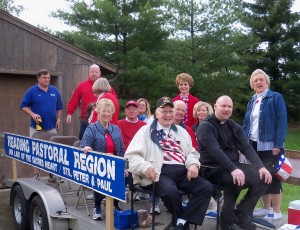
When Precious Blood Father Angelo Anthony became pastor of Dayton Pastoral Region 7, comprised of Holy Trinity, St. Joseph and Emmanuel Parishes, in 2011, he said, “one of the biggest pieces we needed to work on was building trust,” amid concern over potential parish closures.
A new pastor wouldn’t normally make immediate changes in the parishes’ Mass schedule, but it was necessary for both practical and personnel reasons, he said. Conducting a survey in the parishes to determine specific liturgical needs, as well as keeping parishioners engaged in the process went a long way toward ensuring a smooth transition process.
Father Anthony said a challenge has been getting to know all the parishioners and becoming acquainted with the gifts they have to offer. A strategic planning survey, developed with assistance from Michael Vanderburgh, director of the archdiocesan Stewardship Office, helped draw forth the gifts and talents of parishioners.
Two areas in which their pastoral region has been particularly successful in collaborating on are health ministry and outreach to the needy in downtown Dayton community, in particular through St. Vincent de Paul.
“What we’ve tried to focus on is how we can better evangelize and celebrate the Catholic faith and do this in a stronger way by combining our voices,” Father Anthony said.
The next step is taking data from the survey and determining how to move forward.
Reflecting on the past, present and future of the pastoral region, Father Anthony said, “The Holy Spirit has certainly been involved in this. There are a lot of good things happening. We don’t know what parish life will hold in the future and we know there will be bumps along the way, but there is an openness to the path we’re on and parishioners want to see their parishes grow and thrive.”
It’s that same sense of openness and hope for the future that Cecilia Bosticco, a member Our Lady of Sorrows in Monroe and co-chair of the pastoral council, believes will lead to a smooth transition when her parish, along with Holy Family in Middleton and Holy Name in Trenton, becomes a pastoral region effective July 1. Father Ed Pratt, current pastor of Our Lady of Sorrows, will assume pastoral responsibility for Holy Name, and Father John Civille will continue as pastor of Holy Family until his anticipated retirement in 2015.
“It’s good for us to have this call that we are part of a larger church,” Bosticco said. “It doesn’t have to be as hard as people think it might be.”
Father Pratt believes a Pastoral Region Prayer, written especially for their parishes and currently being prayed at all Sunday Masses and at the opening and closing of all meetings, is helping reinforce the faith and sense of unity among parishioners as the transition approaches.
“We certainly believe in power of prayer, and the power of this prayer has been incredible,” he said. “To be able to say this prayer of transition and ask for guidance, gives us the sense that things will be ok.”
Immediate plans for the region, said Father Pratt, include meetings between him, Father Civille and the permanent deacons from all three parishes to see how the deacons can serve throughout the area. There are also plans for combined staff and pastoral council meetings and publicizing each parishes’ daily and weekend Masses.
In the Reading Pastoral Region, comprised of Sts. Peter and Paul and Our Lady of the Sacred Heart, the focus has been more on opportunities than challenges since the region was formed effective July 1, 2012, said Father David Howard, pastor. Prior to that, the faith communities had already been collaborating on activities such as RCIA and shared Lenten and Advent prayer services.
“That preparation aided in the transition, as did actively involving parishioners in the process and emphasizing that ‘we’re all this journey together,’ and acknowledging that there would be some trial and error, and that’s ok,” Father Howard said.
Sts. Peter and Paul pastoral council chairperson Tony Gertz recalls the “competition” that sometimes existed between Reading’s two Catholic parishes, mainly in the form of school athletics. He now finds it rewarding that the faith communities have such a strong sense of unity. What has helped, he said, is that “both parishes have been able to keep their individual sense of identity, yet still be grateful that we can come together as church.”
A recent example of the unity present in the Reading Pastoral Region was a shared flatbed float in the community’s Memorial Day Parade. Sts. Peter and Paul Worship Commission Chair Dee Lynd of Reading organized the parishioners from both parishes.
“We now know what the Lord meant, when He said, ‘Love Thy Neighbor,’” she said.


